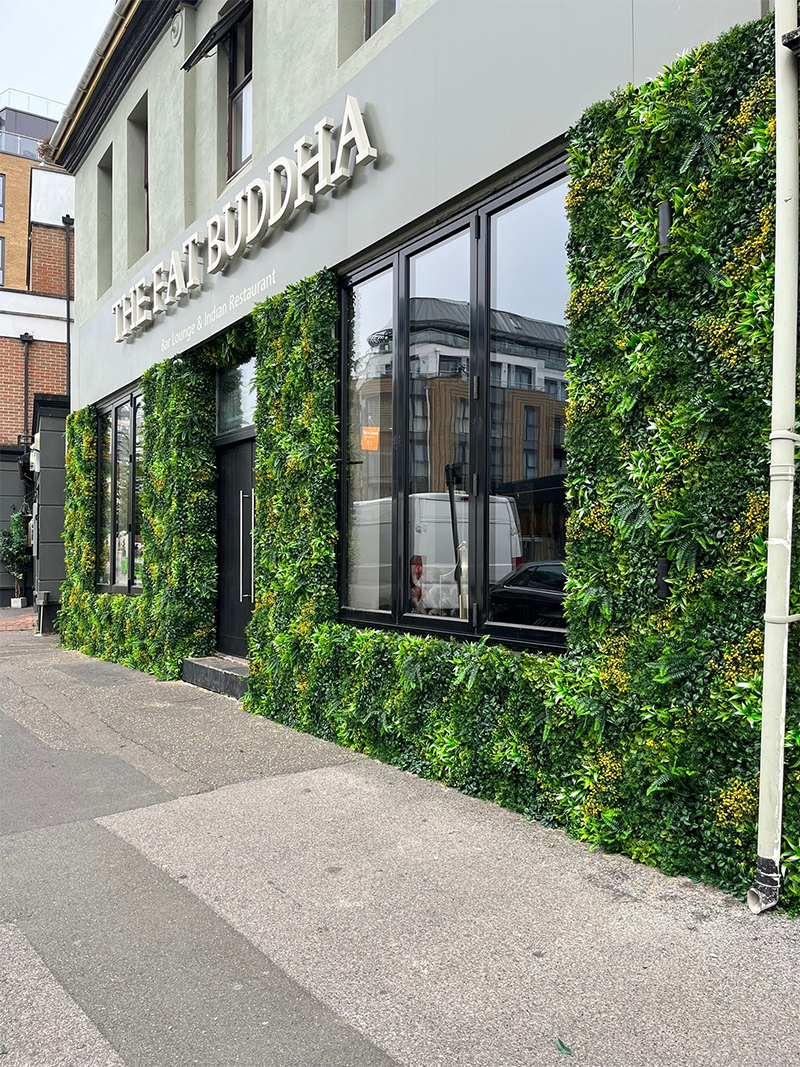Enhancing Vertical Greening Effects in 3D Artificial Vertical Gardens: Techniques for Depth, Realism, and Environmental Impact
3D artificial vertical gardens offer a versatile solution for transforming blank walls, partitions, or underutilized spaces into vibrant green installations. Unlike traditional flat green walls, 3D designs incorporate depth, texture, and layered planting to create a more immersive and lifelike appearance. These gardens not only elevate aesthetics but also contribute to environmental benefits such as improved air quality and noise reduction. Below are key strategies for maximizing the vertical greening effects of 3D artificial vertical gardens.

The illusion of depth is critical for achieving a natural, dynamic look in artificial vertical gardens. By designing planting structures with varying depths, designers can mimic the organic complexity of real ecosystems, making the garden appear more three-dimensional and engaging.
Tiered Containers for Vertical Progression: Use containers or panels of different depths to create a stepped effect, with plants positioned at varying heights. For example, place taller artificial plants in deeper containers at the top or center, and shorter varieties in shallower ones toward the edges. This arrangement enhances visual interest and prevents the garden from looking flat.
Offset Panels for Overlapping Foliage: Install panels at slight angles to one another, allowing artificial plants to overlap and create shadows. This technique adds depth by simulating the way real plants grow in layers, with some leaves casting light on others. The interplay of light and shadow enhances the garden’s realism, even without natural sunlight.
Recessed Areas for Hidden Details: Incorporate recessed sections within the garden to tuck smaller artificial plants or decorative elements, such as faux moss or stones, out of direct view. These hidden details emerge as viewers move around the garden, adding a sense of discovery and complexity to the design.
Artificial plants can be arranged to replicate the irregular, organic growth habits of living foliage, ensuring the garden feels authentic and unforced. Thoughtful placement prevents the design from appearing too rigid or symmetrical, which is a common pitfall of artificial installations.
Asymmetrical Layouts for Dynamic Energy: Avoid evenly spacing plants or aligning them in straight rows. Instead, cluster artificial varieties in irregular groups, allowing some stems to lean or drape naturally. For example, pair a tall artificial fern with a shorter, trailing vine, letting the vine spill over the edge of its container to create a casual, lived-in look.
Directional Growth for Realistic Flow: Position plants so their “growth” appears to follow natural patterns, such as upward for upright varieties or downward for trailing ones. Use artificial stems that can be bent or adjusted to mimic the curves of real plants, adding fluidity to the design. This attention to detail makes the garden feel as though it has evolved over time.
Seasonal Adaptations for Timeless Appeal: While artificial plants do not change with the seasons, their arrangement can still evoke different moods throughout the year. For example, incorporate artificial flowers or berries in warm tones for a spring-like feel, or use deep greens and muted textures to create a cozy, autumn-inspired garden. Rotating decorative elements, such as faux birds or insects, can also refresh the design periodically.
Although artificial vertical gardens do not require watering or pruning, they can still contribute to environmental sustainability by improving air quality, reducing noise, and supporting biodiversity in urban settings. These benefits enhance the garden’s value beyond mere aesthetics.
Air Purification Through Material Selection: Choose artificial plants made from non-toxic, recyclable materials that do not off-gas harmful chemicals. Some manufacturers offer eco-friendly options infused with natural elements, such as activated charcoal, to help filter pollutants from the air. While not as effective as living plants, these materials still provide a marginal improvement in indoor air quality.
Noise Reduction with Textured Foliage: The dense arrangement of artificial plants can help absorb sound, making them ideal for busy offices, restaurants, or residential areas near highways. Opt for varieties with thick, textured leaves, such as faux monstera or rubber plants, to maximize noise reduction. The 3D structure of the garden further enhances this effect by creating multiple surfaces for sound to bounce against and dissipate.
Biodiversity Support in Urban Spaces: Artificial vertical gardens can serve as habitats for small insects, birds, or pollinators, especially in areas where natural greenery is scarce. Incorporate features like faux birdhouses, insect hotels, or nesting materials to encourage wildlife activity. While artificial plants do not provide food, they can still offer shelter and nesting sites, contributing to urban ecological balance.
Strategic lighting can transform an artificial vertical garden into a striking focal point, especially in low-light environments or at night. By highlighting key plants and creating shadows, lighting enhances the garden’s depth and realism, making it appear more vibrant and alive.
Up-Lighting for Dramatic Silhouettes: Place lights at the base of the garden, angled upward, to cast shadows on the wall behind the plants. This technique emphasizes the garden’s three-dimensional structure and creates a dramatic, moody effect. Use warm-toned lights to enhance the green hues of the artificial foliage.
Down-Lighting for Soft Illumination: Install overhead lights to mimic natural sunlight, casting a gentle glow over the entire garden. This approach works well for highlighting delicate textures, such as faux ferns or moss, and creates a welcoming ambiance in indoor spaces. Adjust the intensity of the lights to avoid harsh glare on reflective plant surfaces.
Spotlighting for Focal Points: Use targeted spotlights to draw attention to specific artificial plants or decorative elements, such as a cluster of faux flowers or a unique container design. This technique creates visual hierarchy within the garden, guiding the viewer’s eye through the composition and adding depth to the overall design.
By creating depth through multi-layered structures, mimicking natural growth patterns, integrating environmental benefits, and leveraging lighting, 3D artificial vertical gardens can achieve a lifelike, impactful greening effect. These techniques ensure the garden remains visually engaging, sustainable, and adaptable to a variety of spaces and purposes.
Contact: Amy
Phone: 86-15311787313
E-mail: info@foszmac.com
Whatsapp:86-15311787313
Add: Fengtai District, Dacheng Road, No.24 Building, Room 203, Beijing, China